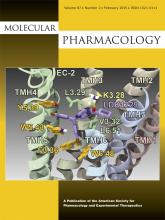Abstract
Voltage-gated sodium (Nav) channels are essential for membrane excitability and represent therapeutic targets for treating human diseases. Recent reports suggest that these channels, e.g., Nav1.3 and Nav1.5, are inhibited by multiple structurally distinctive small molecule drugs. These studies give reason to wonder whether these drugs collectively target a single site or multiple sites in manifesting such pharmacological promiscuity. We thus investigate the pharmacological profile of Nav1.5 through systemic analysis of its sensitivity to diverse compound collections. Here, we report a dual-color fluorescent method that exploits a customized Nav1.5 [calcium permeable Nav channel, subtype 5 (SoCal5)] with engineered-enhanced calcium permeability. SoCal5 retains wild-type (WT) Nav1.5 pharmacological profiles. WT SoCal5 and SoCal5 with the local anesthetics binding site mutated (F1760A) could be expressed in separate cells, each with a different-colored genetically encoded calcium sensor, which allows a simultaneous report of compound activity and site dependence. The pharmacological profile of SoCal5 reveals a hit rate (>50% inhibition) of around 13% at 10 μM, comparable to that of hERG. The channel activity is susceptible to blockage by known drugs and structurally diverse compounds. The broad inhibition profile is highly dependent on the F1760 residue in the inner cavity, which is a residue conserved among all nine subtypes of Nav channels. Both promiscuity and dependence on F1760 seen in Nav1.5 were replicated in Nav1.4. Our evidence of a broad inhibition profile of Nav channels suggests a need to consider off-target effects on Nav channels. The site-dependent promiscuity forms a foundation to better understand Nav channels and compound interactions.
Footnotes
- Received July 16, 2014.
- Accepted November 24, 2014.
H.Z. and B.Z. contributed equally to this work.
This work was supported by a Johnson & Johnson COSAT award to B.Z; and the National Institutes of Health [Grant U54-MH084691] to M.L.
↵
 This article has supplemental material available at molpharm.aspetjournals.org.
This article has supplemental material available at molpharm.aspetjournals.org.
- Copyright © 2014 by The American Society for Pharmacology and Experimental Therapeutics
MolPharm articles become freely available 12 months after publication, and remain freely available for 5 years.Non-open access articles that fall outside this five year window are available only to institutional subscribers and current ASPET members, or through the article purchase feature at the bottom of the page.
|







